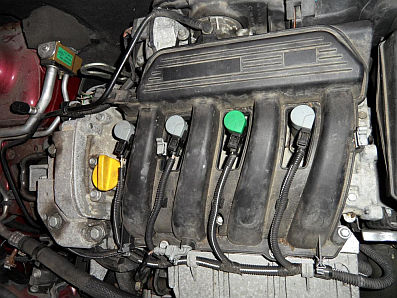|
Purpose of this article is to demonstrate some real life examples of using TOAD OBD software to diagnose real life vehicle problems.
Case 1: P0110 Temperature sensor fault on a Citroen Saxo
 Fig 1. Fig 1. |
P0110: Air intake temperature circuit - malfunction (petrol 1.6 16V 120 hp engine)
The image opposite (Fig. 1) shows a diagnosis done on a Citroen Saxo 1.6 16v.
Although there is no fault indicator lit on the dashboard, a reading done using our TOAD software reveals a problem.
The ECU is showing a P0110 fault code, indicating a malfunction in the air temperature sensor circuit.
A glance in the car's technical manual gives more information about this sensor.
Like most temperature sensors, this one works on the principle of NTC (Negative Temperature Coefficient), the electrical resistance in the sensor changes according to the temperature it is at.
The technical manual will also indicate the location of this sensor in the engine compartment.
|
 Fig 2. Fig 2. |
With this data, the sensor would seem to be at fault. Using a multimeter set to ohmmeter (Fig. 2), measuring the resistance at the sensor terminals shows a "1" on the left of the screen meaning the circuit is open caused by a sensor malfunction.
After replacing the air sensor, the fault code can be cleared using the clear button. The engine will now operate more optimally knowing the real air intake temperature. To confirm that the repair was successful, redo an OBD reading after doing a drive cycle.
One question remains: why did the malfunction of this sensor not appear on the dashboard?
Not all faults are considered critical enough to lead to an alert for the driver. For the air temperature sensor, the injection ECU will use a default value or an estimate that will replace the real value no longer available.
|
Case 2: Fault P0380 / P0670 Glow plugs
 Fig 2-1. Fig 2-1. |
P0380: Glow plug/Heater, circuit A - malfunction (2.0 HDi engine)
This fault code does not light a lamp on the dashboard. It indicates a problem in the preheating circuit.
This generic fault code does not specify the exact cause of the problem. The probable cause is a malfunction of the glow plugs themselves. They operate on a simple principle.
They are comprised of a heating resistance which, when powered, will heat up the combustion chamber during the first seconds of engine operation to facilitate ignition (Pre-heating) and accelerate temperature rise in it (Post-heating).
|
 Fig 2-2. Fig 2-2. |
They can be tested one by one, without necessarily removing them (Fig 2-1). Remove the connector or power wires and test them using a multimeter set to ohmmeter. They usually have a resistance of the order of 0.7 Ohm. Most multimeters are not accurate enough to measure this type of resistance.
The display will show a resistance of 1 or 2 Ohm. This is enough to tell if the plug is working.
Malfunctioning plugs have cut internal resistance (Fig 2-2 infinite resistance).
P0670: Glow plug control module - malfunction (DCi engine)
Dci engines by Renault/Nissan will show a different fault code. Like for the P0380 fault code, the cause of the problem is not clear. The procedure is the same.
First test the glow plugs. If they are in good condition, the second more likely hypothesis is a problem in the relay control unit which powers the plugs during pre/post heating.
Using a multimeter set to voltmeter, test the voltage across the plug terminals during preheating.
|
Case 3: Fault P0301 / P0302 / P0303 / P0304 Misfires detected
 Fig 3-1. Fig 3-1. |
P0303: Cylinder 3 - Misfire (Renault - petrol engine 1.6 16V 95 hp)
We diagnosed the vehicle, a 2005 Renault Kangoo using an ELM327 and our TOAD software.
This Kangoo was losing power, the MIL indicator on the dashboard was lit. Reading of the fault codes confirmed a single fault: P0303.
The vehicle electronics detected an ignition problem on cylinder 3. To identify it, check a technical automobile review. Otherwise, cylinder no. 1 is usually next to the flywheel (in our case no. 1 is on the right in the photo), then count up to 3 from the left.
Initially, start with usual basic verifications. Have the ignition plugs been replaced regularly? Is there a connection problem or a breakage?
Is the electrical harness cut or worn? In our case, the vehicle had been services and no apparent problem was detected.
|
|
Looking more closely (fig 3-1), we can see that one of the ignition plugs (cylinder no. 2) has green plastic. This is not the original part and has already been replaced. Some petrol engines at Renault have experienced weakness in the ignition plugs (a quick search on the internet confirms this)
Removing the plug (fig 3-2) to test it will allow us to confirm this hypothesis. After removing and replacing the coil, the car seems no longer to suffer from a loss of power.
The fault code can now be cleared before doing a road test and confirming using mode 7 available in TOAD that the fault has really disappeared.
|
 Fig 3-2. Fig 3-2. |
Ready to own TOAD car diagnostic kit? Click here to get started...
| 










